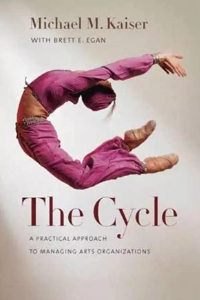 The Cycle: A Practical Approach to Managing Arts Organizations, by Michael M. Kaiser with Brett E. Egan
The Cycle: A Practical Approach to Managing Arts Organizations, by Michael M. Kaiser with Brett E. Egan
Hardcover/Ebook
212 pages
$26.95
Brandeis University Press
Published September 3, 2013
ISBN-10: 1611684005
ISBN-13: 978-1611684001
Michael Kaiser, president of the John F. Kennedy Center for the Performing Arts, has released The Cycle: A Practical Approach to Managing Arts Organizations. This book forms a trilogy of brilliant analysis of the field of arts management, joining with his previous invaluable contributions, The Art of the Turnaround and Leading Roles. Both of those books were reviewed in Senza Sordino upon their release. Brett Egan, who joins Mr. Kaiser as an author of the current release, is the director of the DeVos Institute of Arts Management at the Kennedy Center.
Mr. Kaiser makes the case that, to be successful, arts organizations must create a family atmosphere that invites staff, board, audience members, artists, and donors to feel ownership of the organization. Should any aspect of this cycle fail, the success of the organization is undermined. Each chapter of the book works effectively to demonstrate that artistic programming, marketing, fundraising, and board development are all interlinked. He describes the “cycle” by saying: “Successful arts organizations make interesting art that they market aggressively to potential customers. But at the same time, they must create allegiance to the organization; this is what motivates subscribers, contributors, board members, and volunteers to participate. When the arts organization attracts supporters, they produce revenue that the arts organization can use for creating better art the next season. This art, supported by aggressive marketing campaigns, attracts new supporters who produce more revenue.”
The book is filled with strong statements that are both brilliant and deceptively simple, but too many organizations ignore these concepts. He stresses that “there is one fundamental truth about arts management: the key to a healthy arts organization is strong, exciting, surprising programming.”
He also makes the case that across-the-board salary freezes and reductions can be dangerous for an arts organization. “Almost always, the money that is saved is marginal, but the cost can be substantial.” He bemoans what he calls a “slot mentality” to programming, where organizations view programs simply as “slots” to be filled as opposed to opportunities to create exciting art that enhances institutional marketing. “Dynamic programming institutes a healthy cycle….” Prominent among the reasons he cites for why an arts organization gets “sick” is “neglect of family” and “mission drift.” I think we all can think of orchestral organizations that are struggling due in part to those two concepts.
Once again, Mr. Kaiser has made a tremendous contribution to the field, and this book should be required reading for every musician, as well as every manager and board member. And once again, we will all encourage our boards and managers to read his work, but we can expect resistance. I’ll never understand why so many managers and boards are hesitant to embrace this strong message, given all the success that Mr. Kaiser has built through these principles. Still, I encourage all of our players’ associations to buy a copy for both their CEO and their board chair, and maybe have your entire orchestra sign the inside cover page as a gift.
[Editor’s Note: The DeVos Institute of Arts Management at Kennedy Center hosts a number of interesting arts management resources on two of its websites (devosinstitute.org and artsmanager.org), including videos, papers, and Michael Kaiser’s blog. A 20-page PDF paper of what appears to be a summary of the book being reviewed is currently available at am.artsmanager.org/kcdocument/ArtsManagerDocuments/ The%20Cycle%20Final.pdf (or just browse the artsmanager.org site, go to the Resource Center tab, then look under Documents).]





